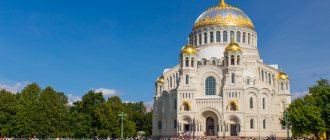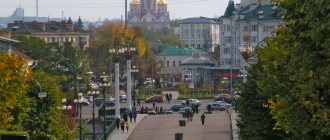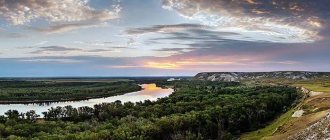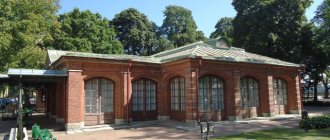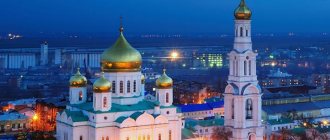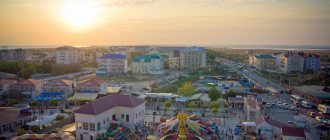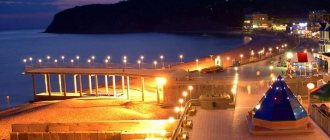- August 26, 2018
- Directions
- Liliya Shevchuk
Stary Oskol is a city located on the banks of the river of the same name in the Belgorod region of Russia. Coming here, every tourist asks the question: where to go for fun in Stary Oskol, what attractions are there, what can you see? But this city is interesting not only for its history and military glory - there are many historical, cultural and natural monuments here.
Brief information about the city
Before recommending where to go in Stary Oskol, you should tell us a little about the city itself. Its history began in the 14th century from a small village called Ugly. In 1571, by decree of Ivan the Terrible, Angly was transformed into the Oskol fortress, which served to protect the southern borders of the state and strengthen them. In 1596, Oskol acquired the status of a city, and in 1655 it received the prefix “Old” to its name, since one of the neighboring cities began to be called Novy Oskol.
The city may be of interest to a huge number of tourists: some will be interested in ancient buildings, others - the military glory of the Great Patriotic War, captured in sculptures and memorials, and others will be most interested in natural monuments of federal significance. Let's take a closer look at the most interesting places in Stary Oskol, where every tourist should go.
City `s history
In the early Middle Ages, from about the 5th century AD, on the site of modern Stary Oskol there were settlements of the Khazar Kaganate. In addition to hunting and fishing, residents were engaged in the extraction of iron ore that came to the surface and smelting metal.
In the IX-X centuries. the lands became part of Kievan Rus, the troubled border area was called the “Wild Field”.
The first official information about a settlement at the confluence of the Ublya and Oskol rivers dates back to 1300. The chronicle mentions the village of Ugly, which territorially belonged to the Principality of Lithuania. The border of the Golden Horde passed nearby.
In 1571, during the reign of Tsar Ivan IV the Terrible, the southeastern border of Rus' lay near the village. To protect the borders from Tatar raids, the Ust-Ublinsky fort was built on a high cape, which became the first in a series of border fortifications.
Scientists were able to restore the data: the perimeter of the fort did not exceed 100 m, on the south side there was a watchtower. Inside the perimeter there were 2-3 residential huts, stables and outbuildings.
By 1593, the defensive importance of the fort decreased, and a civilian city began to form on the site of the military fortification. By 1599, the Cossack Settlement was founded on the Oskol River.
In the next century, 8 more settlements appeared on the coast.
In 1616, the settlement was burned by an enemy detachment and was completely restored within a few years.
By 1655 the city received its modern name.
In 1894, construction of the Yelets-Valuyki railway began, Stary Oskol became part of regular railway traffic.
In 1930-31 Significant ore deposits were discovered in the surrounding area. In a short time, mine No. 1 was built and active extraction of raw materials began.
In 1954, the city was included in the Belgorod region.
During the period 1960-1970. Industrial development of the Stoilensky and Lebedinsky quarries began.
After the construction of the city-forming electrometallurgical plant, the region is experiencing a stable economic recovery.
"Ataman Forest"
First of all, among the attractions of Stary Oskol, we should mention the memorial complex dedicated to the soldiers of the Great Patriotic War, which was created in 1968 on the territory of the Ataman Forest. The name of the memorial is due to the fact that since 1943 there have been a large number of unmarked burials and mass graves in this forest.
The memorial acquired its modern appearance in 1980. This event was timed to coincide with the 35th anniversary of the Victory. The memorial stele is surrounded by greenery, surrounded by small areas that serve as a reminder of the ancient forest. In addition to the monument to military glory built here, the Ataman Forest is also distinguished by the fact that it is a natural monument of the city.
House-Museum of Eroshenko
The museum is open in the house where the Soviet writer, musician and popularizer of the artificial language Esperanto was born and spent his youth.
Now the name of Vasily Yakovlevich Eroshenko, one of the most famous natives of Stary Oskol, is practically unknown to anyone. But this man, who lost his sight at only 9 years old, was an example of courage and determination. Despite his illness, he learned Esperanto, studied at the Royal School for the Blind in Great Britain, and then at the School for the Blind in Tokyo (Japan). He traveled a lot, wrote poetry, essays and fairy tales in Esperanto and Japanese, performed translations, and was seriously interested in music. The museum, opened in 1968, is dedicated to Vasily Yakovlevich. The exhibition is interesting not only for its acquaintance with the life and work of Eroshenko, but also for the general way of life of the Stary Oskol district at the turn of the 19th and 20th centuries.
Museum of Mineralogy
For those who are wondering where to go in Stary Oskol with a child, the Regional Mineralogical Museum will be an interesting place to visit. The museum's exposition, located in the building of the Geological Prospecting University, dates back to 1935. Exhibits of that time include minerals and rocks mined during the work of the KMA trust.
Currently, the museum’s collection includes more than six thousand minerals, rocks and iron rocks, found not only in the region, but also beyond its borders (these are especially rare and interesting exhibits). A visit to the museum will be useful for the general development of both adults and children, and children’s acquaintance with the natural treasures of our planet can instill a previously unfamiliar hobby.
"Alpika", Belgorod district
The Alpika sports and fitness complex has been operating since January 2014. It is located in the village of Dubovoe.
Directions to Alpika, illustration alpika-complex.ru
On weekdays it is open from 2 pm to 9 pm, on weekends from 10 am to 9 pm.
The complex has a parking lot, a hotel and a restaurant. You can rent ski equipment at the rental point. It includes skis, poles, bindings and boots. There are five tracks in Alpika, the longest of which is 300 meters. There are training trails for children, and you can practice with an instructor. Of all the resorts in the region, only Alpika has a chair lift.
You can also go snowboarding and snow tubing here. There is a separate slide for “cheesecakes” (as snow tubes are usually called - editor's note).
Scheme of the Alpika base, illustration alpika-complex.ru
You need to pay separately for ski rental and separately for lifts. Prices vary depending on ski days. So on weekends, for example, you need to pay 400 rubles for an hour, for two hours - 500 rubles , for three hours - 600 rubles , and for the whole day - 800 rubles . On weekdays, skiing is cheaper.
An hour of operation of the lift costs from 350 rubles , two hours - from 600 rubles . The editors have found out that the information on the Alpika website is out of date, so it is better to check with the administrator for details by calling +7 (4722) 402-470 .
“Alpika”, photo by Dmitry Romanenko
Šmarna Cave
There are also unusual entertainments in Stary Oskol. Those who love interesting and truly ancient places should visit the cave in the Starooskolsky village of Shmarnoye. It was after the discovery of this landmark that it became known that people lived on these lands long before the 16th century. The miraculously preserved underground chalk corridors were most likely part or independent premises of an ancient monastery. This assumption is caused by the similarity of the cave with other underground monastic buildings in the Belgorod region, such as the Kholkovsky Cave Monastery and the underground temple of Ignatius the God-Bearer. While exploring the cave, you can see crosses carved on the walls and the remains of sayings written in the ancient Slavic language.
General information
Stary Oskol is the administrative center of the urban district of the same name, which includes 3 cities and adjacent rural areas. The total area of the district is 1693.5 square meters. km.
All borders of the region are determined by land administrative boundaries and do not have clear outlines. In the east the district borders on the Voronezh region, in the north on the Kursk region. The region is surrounded from the west, south and southeast by districts of the Belgorod region.
Stary Oskol is located in the Belgorod region, 22 km from the border with the Kursk region. The city is located on a large hill, off the banks of the navigable Oskol River and its tributaries. The area of the settlement is 134 square meters. km, altitude 154 m. Although the city has a small airport serving charter flights, it is more convenient to get there by train or intercity bus.
Airports are located in the nearest major centers:
- 124 km to Voronezh;
- 142 km to Kursk;
- 153 km to Belgorod.
The coat of arms of Stary Oskol, approved in 2008, almost completely repeats the historical symbol approved in 1780 by Empress Catherine II.
The image is made in the form of a beveled shield, divided diagonally: in the right, red part, a gun with a gilded butt, a stylized golden plow in the green left part. In the upper left corner is the coat of arms of the Belgorod region. The shield is crowned with a golden crown with five teeth in the shape of defensive towers.
House of merchant Likhushin
Tourists who are interested in where to go in Stary Oskol in the evening should definitely just take a walk around the city. At nightfall, beautiful ancient buildings, illuminated by special spotlights, acquire picturesque beauty and mystery. One of these beauties is the former house of the merchant Likhushin, inside of which the Museum of Local Lore is currently located. The exact year of construction of this beautiful mansion is unknown, but it is believed to have been built between 1905 and 1910. The owner of the building until 1917 was the famous Stary Oskol merchant Panteleimon Likhushin. After the revolution, the house was taken away and nationalized. The Stary Oskol Local History Museum, founded back in 1923, moved to the former Likhushin mansion in 1995. Until that time, it housed a communications center, a post office, and a radio center.
Administrative division
The city has partially preserved the ancient layout of the 18th-19th centuries, when the central area was surrounded by five separate settlements: Streletskaya, Yamskaya, Kozatskaya, Lamskaya and Gumny.
The master plan for the city's development was developed and approved in 1995. The zoning scheme divides the city into 6 districts, while the building density both in the center and on the periphery remains low.
Modern residential complexes are being built on the outskirts, and on the central city hill, surrounded by floodplains, ancient temples and merchant houses with carved wood facades have been preserved.
- The North-Eastern region is known for the new high-rise buildings of the Kosmos and Olimpiysky microdistricts, complex transport interchanges and engineering structures. Here is the Ice Palace, the Sports Palace named after. Alexander Nevsky, PromAgro stadium and a large tennis center. The picturesque Polovskaya forest adjoins the area from the east.
- The southwestern region attracts with its convenient buildings, well-groomed parks and the proximity of the pine-covered tracts Grachev Les and Ozhev Les. On the shore of the Sokovo Reservoir there is a recreation area called “Oskoletsky Hydropark”.
- The central district includes 2 microdistricts with administrative and cultural buildings and 6 historical settlements. Here are the majestic Alexander Nevsky Cathedral and the ancient Ascension, Holy Trinity and Baptist churches. On the central street. Lenin there is the Stary Oskol Art Museum and the Museum of the History of Medicine. You can relax on the benches of the SMK Botanical Garden or in the landscaped recreation area of the Gornyashka forest.
- The layout of the Zheleznodorozhny district combines the streets of the historical settlements Lamskaya and Pushkarskaya with modern residential complexes and developed transport interchanges. The area contains the city's railway and bus stations, colleges and universities.
- The industrial Kotelsky and Metallurgical districts , where the main city enterprises are concentrated, are actively developing.
Central district of Stary Oskol
To move between districts, it is convenient to use the network of city buses and route lines. The central areas and the Metallurgical Plant area are connected by high-speed tram lines. It is more interesting to stroll through the compact historical center on foot.
Holy Trinity Church
Where to go in Stary Oskol for lovers of architectural monuments? Holy Trinity Church, built back in 1730, would definitely be the place to be. A beautiful three-altar building, made in the Baroque and late classicism styles, with a unique sculptural crown located under the main dome, will certainly interest lovers of antiquity. And religious visitors will certainly feel the peace on the territory of the temple, characteristic of all churches and holy places with a rich history. In addition to its antiquity, the Holy Trinity Church is one of the few Russian churches that was not damaged during the revolution. Despite the frequent change of priests, both during the Civil War and during the Great Patriotic War, services continued to be held in the temple. During the defense of Stary Oskol from the Nazis, the temple even had strategic significance.
The post-war renovation of the temple was carried out only in the 90s - the Soviet authorities did not allocate funds for the renovation of the church building, despite the fact that church services were never stopped held here. The restoration of the interior paintings of the temple was carried out from 2003 to 2005, and by 2006 the bell tower, upper dome and courtyard were repaired.
Temples and churches
Temple of St. Sergei of Radonezh
Address: Mr. Dubrava, 32A Telephone: Website: https://hram-oskol.ru Opening hours: 07:00 – 19:00, daily Cost: free
The Temple of Sergei of Radonezh was built quite recently. The foundation stone was consecrated in 2007, and the built shrine began to fully function in 2016. At each stage, more and more new parts of the temple were consecrated. On July 21, 2010, bells cast specifically for this shrine were installed.
Inside the temple is decorated with paintings, mosaics and icons, which seemed to come to life after the consecration. The lower church was consecrated in honor of the Feodorovskaya Icon of the Mother of God, which was especially revered in the family of Alexander Nevsky, the heavenly patron of Stary Oskol.
Church of the Ascension of the Lord
Address: st. Mira, 24 Telephone: Opening hours: 08:00 – 14:00, daily Cost: free
The oldest temple was founded in 1870, and it was consecrated twelve years later in honor of the Archangel Michael and the healer Panteleimon. In the first half of the twentieth century, when the authorities fought against the Orthodox Church, Father Andrei, who served in the church, was arrested. Because of this, the temple suspended its activities; in those days, the church premises were used for storing grain.
In the 1980s, restoration of the temple began, and in 2011 the church was crowned with new bells, purchased with funds from an unknown donor. Currently, the architectural monument has been completely restored and is functioning.
Temple of Princess Olga and Anastasia
Address: st. Tokareva, 4/1
Construction of the small church began in 2007 and ended in August 2008, when it was fully consecrated by Archbishop John of Belgorod and Stary Oskol.
When creating the temple, only wood was used: the building itself was built from larch, and the domes with crosses were made from aspen. Oak was used to make the altar and iconostasis. All trees were brought from Arkhangelsk forests.
The building has a small refectory and a tented bell tower. The church often hosts services, which are attended by students from Orthodox gymnasiums.
If you have not yet chosen where you will live and want to save money when booking, we recommend using the RoomGuru service. Firstly, it contains hotels, apartments and guest houses from many different booking systems, so you won’t miss out on a worthwhile option. Secondly, you can immediately compare prices for one place in different services and book where it is cheaper (this is not always Booking!).
Alexander Nevsky Cathedral
Another church-historical attraction that is definitely worth visiting in Stary Oskol is the Cathedral of Prince Alexander Nevsky. Built in 1903, the temple amazes with its beauty: the building is built of dark brick, decorated with black domes with stars, and the external gilded iconostasis is made of carved wood. The cathedral is a truly majestic architectural monument of the beginning of the last century, combining Greek and Old Russian styles.
Unlike the Holy Trinity Church, this cathedral was closed after the revolution, in 1930. But after the Great Patriotic War, by the end of 1945, his parish was restored. In 1995, the cathedral became a cathedral - the second in the recently recreated dioceses of Belgorod and Stary Oskol. In 1999, new icons were painted for the iconostasis. They were made by masters of icon painting of the Trinity-Sergius Lavra in the style of Andrei Rublev in compliance with modern standards of the Orthodox icon painting canon, revealing an independent landmark of the temple.
Buildings and monuments
Stary Oskol Local Lore Museum
Address: st. Lenina, 50/52 Phone: ; Website: https://sokm.org.ru Opening hours: 10:00 – 17:30 Tue-Sun, 10:00 – 14:00 Fri, from June 1 to August 31 10:00 – 19:30 Thu, Mon – day off Cost: 60 rub.
The Stary Oskolka Local History Museum was created on the basis of a circle that worked at the Proletarian Club, opened in 1923. The first exhibition was assembled with the active participation of local residents, who brought gifts of things of historical value, ancient books, household items and handicrafts.
Precious exhibits were almost completely destroyed during the Great Patriotic War, but by the end of April 1945 the exhibition was reassembled. Every year the exhibitions are replenished with new items.
The main task of the museum is to preserve and popularize historical and cultural monuments that are directly related to Starooskol. Visitors have the opportunity to get acquainted with the peculiarities of people's lives since ancient times by visiting seven permanent halls where the most interesting exhibits are located. The museum's complete collection numbers more than 40 thousand items.
Stary Oskol Theater for Children and Youth
Address: st. Revolutionary, 15 Phone: Website: https://teatroskol.ru Opening hours: ticket office – 11:30 – 19:00 Tue-Fri, 11:00 – 19:00 Sat-Sun, 14:00 – 15:00 break Cost : from 100 rub. up to 700 rub.
The head of the city signed the decision to open the city theater on February 1, 1996. The first acting group of the theater was created in Sevastopol by Lyudmila and Viktor Orshansky. The troupe came to Stary Oskol for a performance, but stayed here forever after the proposal of the head of the city.
Over twenty years, the actors have won many valuable awards, for example, Sergei Lysenko and Marina Kartseva received the regional award named after Mikhail Shchepkin. The theater's repertoire includes well-known and beloved fairy tales by children:
- "Mermaid";
- "The Steadfast Tin Soldier";
- "Ugly duck".
The Stary Oskol Theater has its own legend - this is the actor Evgeny Vasilyevich Baturin, who brought to life the most complex characters and appeared on stage almost until his death.
Dyakov's office
Address: st. Oktyabrskaya, 20
In the historical center of the city there is a monument of urban planning and architecture - the office of the merchant Dyakov. Once upon a time it was erected on the territory of an oil mill that belonged to a merchant.
The monument attracts attention with its architectural features and Art Nouveau style details.
Now the office is run by a local confectionery factory.
Stoilensky GOK
Address: southwestern industrial district, Fabrichnaya site, passage 4 Telephone: Website: https://sgok.nlmk.com/ru/ Opening hours: by agreement with management
In the industrial area there is the Stoilensky mining and processing plant, which is one of the main companies in Russia for the production of iron ore. The company specializes in the extraction of iron ore concentrate and iron sinter ore. The Kursk Magnetic Anomaly deposit is being developed here.
Steam locomotive "SU 211-75"
SONY DSC
Address: st. Victory
Near the railway workers' park there is a monument to labor glory in the form of a steam locomotive leaving the tunnel. The Su-211-75 was parked in 1979, when the city authorities decided to perpetuate the feat of railway workers during the Great Patriotic War.
In the most difficult conditions, they transported weapons and ammunition to soldiers who fought on the Central and Voronezh fronts. During the war, the locomotive also worked to transport passengers. This heavy truck was produced at the Sormovo plant, as indicated by the first letters in the name.
Promagro
Address: Molodezhny Ave., 12 Telephone: 8 (4725) 485702, 8 (4725) 485703 Opening hours: daily, around the clock Cost: free
There is a large Promagro stadium in Stary Oskol, open to the public. Here you can play sports, ride a bicycle or rollerblades, or play on the tennis courts.
In the past, the stadium was the home field for the Metallurg-Oskol football club.
City heart
Address: Vostochny microdistrict, 32
In the east of the city, next to the confectionery-bakery “Shu-shu”, there is a small sculptural form, which is called the “Heart of the City”. The small sculpture reminds passersby of the mining and metallurgical heritage of Stary Oskol, and also serves as a meeting place for dates and photo sessions.
Monument to Alexander Nevsky
Address: Park of Military Glory, Alley of the First Cavalry Army
In 2010, a festive opening ceremony of the monument to St. Alexander Nevsky, who lived in the thirteenth century, took place in the Park of Military Glory. He is the heavenly patron of the city. His name is recognized by everyone, thanks to his victory in the Battle of the Neva, the Battle of the Ice and successful clashes with the Mongol-Tatars. The celebration was attended by the archbishop, who consecrated the monument, as well as the author of the sculpture, Anatoly Shishkov, who resorted to a complex technique - creating beveled edges.
Copper was used to make the monument, so the weight of the figure is eight hundred kilograms. The height reaches 12 meters. The pedestal made of red granite, imported from Africa and first used in Stary Oskol, bears the phrase “God does not lie in might, but in truth.”
Memorial complex near the Ataman Forest
Address: Southern bypass road, building 1
The architectural landmark of the city belongs to the memorial buildings dedicated to the events of the Second World War. It personifies the courage of the Soviet defenders who stood unwaveringly against the fascist invaders. Thanks to their decisive actions, Stary Oskol was able to survive the war.
At the beginning of July 1942, enemy troops penetrated the city of the year and ran into confrontation between the 21st and 40th operational military formations. In the vastness of the Ataman Forest, from July 4 to July 5, a meeting was held, the main issue of which was the tactics of confronting the fascist invaders. As a result of correct tactical actions, the enemy was unable to cross the Don and capture Voronezh. The second battle was fought and successfully repelled in the Kursk direction.
The idea of erecting a memorial was proposed by the patriotic association “Poisk”. In 1986, mass graves were created for soldiers killed in battle. At the same time, it was decided to install a stele at the burial site. The memorial was opened to the public on the 35th anniversary of the Great Victory. The widow of military doctor Kozlov, who rests in a mass grave, and the Soviet government took an active part in this.
House-Museum of Vasily Eroshenko
Address: Obukhovka village, st. Eroshenko, 15 Telephone: Opening hours: 09:00-17:00, Tue-Sun Cost: 70 rub. How to get there: tram No. 1 from the city, to the stop. “Selo Obukhovka” (3.8 km from the city center)
It is part of the local history museum of the city of Stary Oskol. The attraction has been open to the public since January 12, 1990.
The life of Vasily Yakovlevich cannot be called simple. At the age of four, the boy completely lost his sight, but this did not stop him from becoming a writer-publicist, musician, poet-storyteller, ethnographer and traveler.
The museum is located on a land plot of 2.4 hectares. In the very center is the Yeroshenko house, restored to the smallest detail. Stary Oskol artist-sculptor V.N. Kolesnikov made a bust of the writer. It was installed on the territory of the museum in honor of the memorable date - 120 years since the birth of Vasily Eroshenko (January 12, 2010).
The exhibitions occupy 4 halls and operate on an ongoing basis. The total area is 65 m2. The rooms recreate the atmosphere of the late 19th and early 20th centuries, corresponding to the standard of living of wealthy peasants. The main part of household items belongs to the Eroshenko family.



